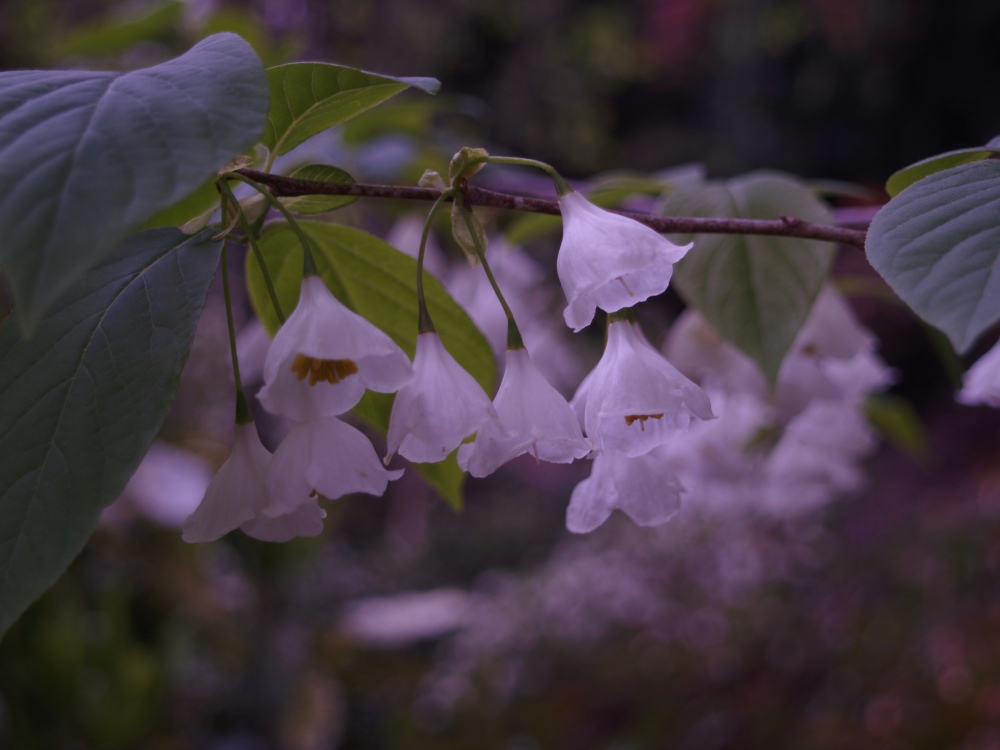Carolina Silverbell (Halesia caroliniana, below) is native to much of the American southeast, though not to Virginia, so it can not correctly be called a native in my garden. No matter, I have trees from across the globe, and none lovelier in bloom than the silverbell. Unfortunately, the dangling blooms have a tissue papery substance, so typically they last for only a short period in the inordinately cold or warm days that are the standard in April. Happily, in this cool, but not cold April the flowers have persisted a week longer, with excellent prospects for at least several more days.
The habitat of Carolina silverbell is similar to that of the native dogwood, and in my garden silverbell flourishes at the wood’s edge growing in the shade of towering swamp maples. In this mostly shaded setting its growth is slightly more upright, and branching less dense than is typical. But, in recent years the lower branches of the thirty foot tall tree have thickened, and flowering is much more evident nearer the ground. Like many flowering trees, Carolina silverbell is unobtrusive through much of the year, but glorious for ten days in April. Given the difficult, root filled soil where it’s planted, I imagine that silverbell is a tough, hardy choice, so long as there is space in the garden for a tree that climbs to forty feet or more.
Finding a Carolina silverbell in a garden center is another matter. There is no economic incentive for tree growers or garden centers to invest a few years growing lesser known trees without a market to sell them, and of course it is shame that fine trees are neglected. When I find such treasures I don’t hesitate to pluck one to add to the garden, and with a tree with such accommodating cultural requirements there is no reason (even in a garden that is fully planted) not to add one.
Growing (and flowering) nearby at the forest’s edge is the equally obliging fothergilla (Fothergilla gardenii, above), a witch hazel relative with pleasant blue-green foliage similar to Vernal witch hazel (Hamamelis vernalis). It is fairly common in garden centers, but scarce in gardens. This southeastern native grows with an open habit when planted as an understory shrub, though it will branch more densely with more sun. Its native habitat is swampy areas, but it seems to grow without a bother in dry shade as well. It has no pest problems, including deer, and I never give it a thought except to enjoy the April bottlebrush blooms and the lush blue green foliage. In autumn the foliage turns a lovely yellow to soft orange to scarlet (below), and certainly there are few shrubs that compare.
For years there was only one fothergilla in the garden, planted on the outside edge of the property so that the neighbor could enjoy it, but in a spot that I don’t visit regularly. There are years when this has caused me to miss its blooms, or autumn foliage, when I was occupied by so many other treats. So, I’ve rectified this by a adding two smaller shrubs on the far side of the garden in the area where brush and brambles were cleared out in early winter. This area is a bit under done at the moment, which is quite a switch for me, but I’ve no doubt that everything will grow together in a few short years. There is nothing that will please this gardener more than seeing tall branches of the fothergilla arching for sunlight from beneath the Bigleaf magnolia and catalpa. Here, I’ll be certain not to miss these marvelous blooms.